The first AFLW trade and free agency period has come and gone, and seen all eight clubs set on slightly different paths on the way to the upcoming season. Whilst the raw number of trades and free agency moves was smaller than the typical AFLM trade and free agency period, the magnitude of the moves may have a wide impact on the entire competition in the years to come.
Player movements
Below is a table of every club’s list from the season just gone, coloured by where players ended up moving for the upcoming season either by trades or free agency moves.
(Click for a larger image)
As we can see, no club was left entirely unaltered with every club except Fremantle losing a player to another side, and only Adelaide failing to acquire an import. Neither side bothered engaging in trading, as segregated draft pools make pick order meaningless to clubs in single-team states. Instead, Freo pinched their homecoming prizes via free agency.
Two clubs (Fremantle and Carlton) now have three players originally designated as “marquees”, a term now discontinued by the league. As the AFLW doesn’t disclose each player’s pay, one can only guess at how these player tiers are split.
Club primary lists for 2018 will be 27 players, with the remainder to be filled up via the draft. At the close of trade period, clubs could only have a maximum 22 players, but we’re unsure that they were permitted to exceed this during the free agency period. None did, however, and only Melbourne seems to have even reached that 22 player total.
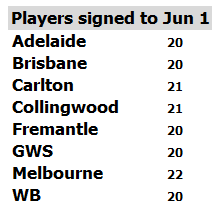
Interstate clubs stayed mostly on the sidelines
Given the segregated draft pools, interstate clubs didn’t have much need to engage in trades for picks. Brisbane and GWS made exchanges prompted by players desiring a move to or from Victoria. Adelaide and Fremantle didn’t bother at all.
Adelaide and GWS, with the weakest local talent pools from which to draw, would have mostly focused on retaining players recruited from interstate. Adelaide had 7 from outside SA/NT and GWS had 10 from outside NSW/ACT. They mostly managed to retain those players and GWS topped up further.
The Giants lost Alex Williams back to WA and Ashleigh Guest to Melbourne, but have replaced those with four other imports via trades and free agency. The loss of Williams will hurt GWS in their already-shaky defence, but Randall and Privitelli are both defenders themselves. Eva adds some serious class to the Giants’ midfield, and Boyd is a ruck/forward who probably comes in to support McKinnon.
Their most unexpected non-signings are two AFL Canberra players, Queanbeyan’s Ella Ross and Riverina’s Clare Lawton, who both played every game at GWS. Lawton is likely on the outer due to the signing of Boyd, but look for both as redraft chances later in the year.
NSW/ACT is as a draft pool is difficult to read from Under-18s results this year – they matched it with the historically stronger Queensland side, going down by just 3. They then lost by 87 points to WA, which is hard to triangulate because Queensland then went on to beat WA in what was, on past results, an upset.
Adelaide couldn’t retain former marquee Kellie Gibson who wanted a return to Western Australia. There has been speculation that Gibson was told that she would move down the pay tiers, but her status as an unrestricted free agent indicates that she wasn’t offered a contract – in line with the Fremantle statement on her signing. As Gibson moved via free agency Adelaide received nothing in return for her loss, presumably because nobody wanted to move slightly east. A trade of picks would have been useless for both teams, due to the state pool draft restrictions.
Gibson aside, their interstate players have all settled in to play in the local comp over the winter and not returned home. Adelaide have therefore taken quite a minimalist approach to the sign and trade period, content to retain players. There is really not much to say about them. The most notable delisting is the behelmeted Heather Anderson, who was badly injured in the Grand Final and if fit will surely be redrafted.
South Australia have also had a couple of stronger under-18 classes in recent years. They currently sit undefeated with two massive wins in the 2017 u18 competition – albeit against weaker competition in Tasmania and the NT (the three teams will form “the Allies” in round 2 matches). As such, the Crows might find enough to replenish their list without looking interstate again.
Fremantle were also minimal participants in the player exchange, content to bring home a couple of big names via free agency. Despite their lack of movement, the Dockers may end up the biggest winners of the entire period. For a club who turned out to be unexpectedly hampered by the loss of the cream of WA’s talent pool, getting back Gibson and Williams is an unalloyed win. Fremantle now have three of the original marquees, having also retained Kiera Bowers who missed the season with an ACL injury. They also now have three priority pick level players from last year, retaining Antonio and Bentley as well as adding Williams.
The Dockers have left a couple of notable players on the table, including midfielder Demi Okely, rebounding defender Akec Chuot and the hard-tackling netball convert top-up in Alicia Janz. We’re more or less assuming the Dockers will look to draft these players if better local options don’t present themselves, but if another club can convince them to relocate, they could enter a different draft pool instead.
WA can probably also be assumed to be producing good under-18s talent, and will no doubt be adding several players this way. So far this year they have had a big win against NSW/ACT and a slightly surprising loss to Queensland.
For Brisbane, they retained their possible flight risks (especially marquee West Australian Sabrina Frederick-Traub) and their main involvement was trying to extract fair return for Tayla Harris. We’ll discuss them when we discuss that trade as a whole were made.
Like South Australia, Queensland sit undefeated in the under-18 competition, but they did it against much stronger opposition, knocking off perennial favourite WA by 10 points. Brisbane will expect to do well as well as anyone out of the upcoming draft.
Trades are for Victorians
Five trades were completed during the exchange period, all unsurprisingly involving Victorian clubs for whom the fungible currency of trade week – draft picks – actually have meaning. However, the four clubs took differing strategies during the week, with Collingwood and to a lesser extent the Dogs trading into the draft whilst Carlton traded out of it and Melbourne focused on player swaps.
We’ve translated the pick trades below into the position they ended up sitting within Victoria, as those will be the competitive element of the draft:

These two trades between GWS and the Dees collectively sent two fringe Melbourne players to GWS in exchange for Guest and a pick that entitles the Dees to the 18th selection within Victoria. Compared to the other moves this is a relatively late pick, and will be the Demons last active pick – and a upgrade of two spots on pick 20.
Pepa Randall was the 16th draft pick for Melbourne, or the 19th player into their list overall. She is only 21 and didn’t manage a game for the Dees in 2017. At VFLW level she has proven to be an effective small forward who has a sense for the goals, but Giants sources call her a key defender. Boyd is a tall who rucks and plays forward. She played every game for the Dees, but as a secondary ruck behind Lauren Pearce and as a forward who didn’t get on the scoreboard at all.
Ashleigh Guest deliberately moved to the Giants this year, nominating for the NSW draft pool. She told an interviewing charity last year “I moved to Sydney from Melbourne in November to put myself out of my comfort zone”. She has apparently decided to move back into her comfort zone and should plug into the Dees midfield.

Nicola Stevens won Collingwood‘s best and fairest in a pretty disappointing year for them. Carlton gave up three picks for Stevens – more or less trading out of the draft and demonstrating how highly they value her (or how lowly they value draft access).
Collingwood’s balance within this trade is probably best assessed in conjunction with the following movement.

Overall the Magpies lose the two players their coaches rated as their best at their awards night – Stevens and Eva. In return they obtain Lambert, who will be potentially one of their best. She was the Dogs’ first draft pick (4th onto the list) and came 7th in the Dogs best and fairest while missing one game and otherwise struggling with a difficult hip injury.
Collingwood emerge from the exchange period down a top established top player on balance, and instead have an extra pick inside the first eight Victorian picks in order to replace the shortfall:
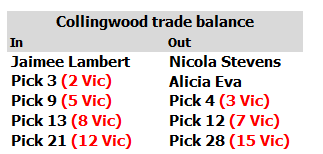
We don’t have a valuation points system suitable to the AFL Women’s Draft at this stage but this move basically represents the addition of another high pick and improvements in position. If we assume Lambert can recover from her injury and be roughly like-for-like for Eva, then the Pies should do well, giving themselves an extra shot at securing a replacement for Stevens from the top of the draft. Collingwood had one of the oldest lists in 2017 so this move may be looking to position themselves for the future for We’ll talk more about the draft below.
The Bulldogs, meanwhile, used this trade to maintain their position at the top of the Victorian draft and improve the position of their second pick. The pick 3 they gave Collingwood was the first Victorian pick, but the GWS pick 1 they gained now becomes the new top competitive pick. A shrewd move.
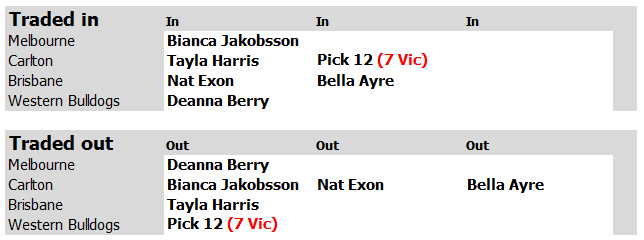
The core of this trade was Brisbane walking the tightrope of trying to get players for Harris without letting her walk and leave them with worthless draft picks via the system of discretionary free agency compensation. They’ve done quite well here, all things considered. Exon was technically a rookie due to her split involvement in athletics and VPL soccer, but she won a VFLW premiership last year before the Blues signed her as a rookie, an odd quirk of the foundation AFLW signing system. Exon ended up one of Carlton’s midfield run and gun players.
The other player traded in was Bella Ayre, who juggled year 12 and a two hour commute each way to training, leaving school at 3:30 and getting home from training at midnight. On paper Ayre is a slight downgrade forward option on Harris, but she starred in a couple of games last year and should allow the Lions’ forward setup to remain basically unchanged.
The Dees shed Deanna Berry to the Bulldogs but obtained Bianca Jakobsson in exchange. They were both mostly forwards, but as with many players, various sources insist they are versatile. Of the two, Jakobsson is a truer tall target, finishing in the top 10 in the AFLW for contested marks and marks inside 50. However, Berry is four years younger than Jakobsson, and might have more room to grow in her game.
This is probably an upgrade for the Dees in terms of their prospects next year, as Jakobsson plays tall. The Dees were relatively average in this area last year – 5th for contested marks per game, 3rd for marks inside 50.
For the Bulldogs, through either style or personnel reasons, they weren’t a great marking side last year. The loss of Berry won’t impact them that much on that front, and they indirectly benefit from Melbourne obtaining Jakobsson here. Melbourne left Jessica Anderson – another full-forward – unsigned. She had only kicked 1 goal and took 7 marks in her 5 games, and on statistical output Jakobsson is a clear upgrade. However, the Bulldogs may find use for Anderson if they want to add another tall to support Brennan, having obtained most of their goals last year from midfielders such as Blackburn, the now departed Lambert, and Lamb.
The Blues surprised us this season with a relatively unheralded group (for a Victorian team) in terms of previously established talent – we noted they had the least elite talent in terms of all-star honours. They then proceeded to embarrass us and other pundits with an organised game based around a small core of top talent supported by the players they pulled from the draft.
They have now taken the exact opposite approach this year after drafting successfully – removing themselves from the draft to an extent, and trading aggressively to secure two gun players:

Carlton did secure their prize in Tayla Harris, as well as the Collingwood B&F in Stevens earlier in the trade period, but have given up plenty in order to do it – three best-16 players and multiple early draft picks.
Who “won” trade period?
The question of which are the right moves move probably hinges on whether this upcoming draft is a mature one useful for building a long term future. Much of the eventual success and evaluation of this trade period will come with the announcement of the player retention rules with respect to the expansion of the AFLW in 2019.
We can conceive of the Collingwood/Bulldogs and Carlton/Melbourne trade periods as (perhaps by necessity) taking opposite bets on the state of the upcoming draft. The Dees were content to take their picks and gain one mid-range new pick, while Carlton left themselves with just one pick from the first 15 Victorian selections – pick 12 overall, or number 7 in Victoria.
The Bulldogs have three selections before Carlton’s first pick, and one a little after it. Collingwood have two picks before Carlton’s first, and then three more soon after. In both quality and quantity terms, the two clubs are positioned aggressively for this draft.
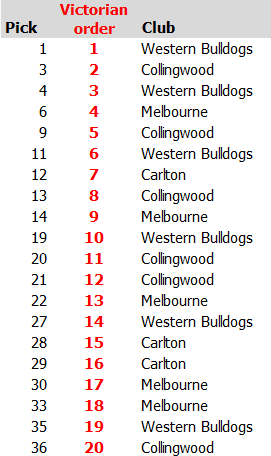
What sort of draft will it be? Last year’s draft was establishing the competition, and presumably collected all of the key established talent of all ages. So the question is whether the incoming young cohort who were too young or undeveloped last year are of sufficient number and quality to provide the multiple elite players needed to justify the bet on the draft.
Damien Keeping at Carlton and Wayne Siekman at Collingwood both have recent experience in Victorian women’s football development. Keeping and Siekman were both in the Vic Metro Youth Girls setup last year. This makes the contrasting positions they’ve taken is especially intriguing in terms of how they might rate the talent pools with which they should be quite familiar.
Check back in five or so years to see who was right.
What about cross-code rookies?
This coming season, rookie listed players will only be able to play if upgraded for an injured player like in the men’s game. This suggests we may not see the same volume of cross-code converts making headlines in future. We’re not sure if clubs will, or can, leave primary list spaces vacant for rookie upgrades.
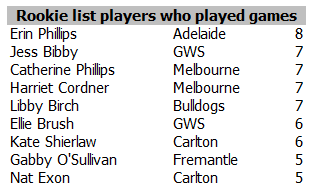
In 2017, nine rookies out of the sixteen played a game, a total of 58%. This was a pretty good strike rate, and a number of players had a real impact. Some of these players had football experience, such as Exon who had played other sports (Victorian Premier League soccer) but also had a football background. Exon won a flag with Darebin before being recruited by Carlton.
Others brought over a generalised athletic skillset that worked in transfer, such as Catherine Phillips (ultimate Frisbee) and Ellie Brush (W-League). Erin Phillips of course, came in as a rookie and combined both a childhood footy background and being an experienced, world class athlete and won the league Best and Fairest.
If we’re looking for players likely to bring similar attributes to the successful rookies, those who might be likely to have an impact if upgraded, we’d nominate Georgie Parker at Collingwood from the small group of announcements. She’s an Olympic level hockey player, an elite standard of athlete, so could be expected to contribute if given the chance. There may also be more signings to come of players with actual football experience – so far only six of a potential 24 rookies have been signed.
However, overall, we should expect to see the cross-code transfer rookie signing reduce in significance with the new list rules.

